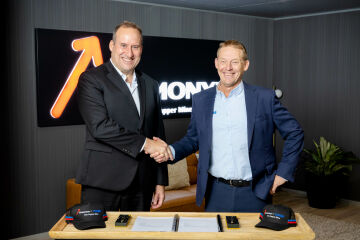min read time
Thiess trialing autonomous technology
Thiess is realising the benefits of drill automation after undergoing a successful field trial at its Mount Pleasant operation.
In collaboration with Caterpillar and WesTrac, Thiess introduced a new Caterpillar MD6250 drill rig with autonomous drilling capability at Mount Pleasant in a phased 12-month pilot project.
The autonomous drilling product uses state-of-the-art guidance technologies to assist operators drill holes to the exact location and depth specified by the drill plan, resulting in safer and more efficient blasting.
Thiess General Manager Autonomous Services Matt Petty said the purpose of the pilot was to test the functionality and application of the technology while determining its viability for Thiess’ team, operations and clients.
“This trial is an exciting opportunity for us to investigate the applicability of the technology at our operations and train our people in the remote management of autonomous equipment,” said Matt.
“The results are showing significant productivity improvements, safer operations and upskilling opportunities for our people.”
The phased pilot program is progressing through three stages of drill automation – operator mission assist, semi-autonomous drilling and full autonomy and perception.
The current stage, semi-autonomous drilling, automates the entire drilling cycle for one row, including moving between holes, from a remote operator station.
“The drill is now controlled by satellite-guided precision ensuring the blast holes are drilled exactly to the design coordinates and desired floor elevation,” said Matt.
“This stage allows our operators to select a row of holes for the drill to navigate and auto drill. “Operators also help to monitor and authorise the auto-tram between holes to ensure safety is maintained.”
In the coming months, the drill will be fitted with proximity detection and collision avoidance technology, enabling full automation.
Mount Pleasant Drill Operator Zac Brasington said the remote operation of the drill had proven safety, precision and equipment utilisation benefits for his team.
Working remotely eliminates operators’ exposure to potential high risk activities and allows the drill to function without operator restrictions," said Zac.
“The remote station replicates the seat and controls of the machine’s cab, allowing us, as operators, to control the machine with minimal decrease in functionality or productivity.
“It’s also helping drive consistency at our operation with improved accuracy in hole placement, trajectory and depth.”
Thiess’ team has been working closely with Caterpillar and the WesTrac team on the implementation plan throughout the trial process.
I’m grateful for the opportunity to work alongside our automation team and WesTrac, to test the technology and pass its benefits to our operation.
“I’ve also had the opportunity to gain new skills and competencies. It’s very rewarding knowing I’m one of the few operators, worldwide, who is able to operate an autonomous drill.”
The outcome of the trial will help to inform how Thiess delivers automation as part of its services offering.
Thiess is continuing to work with its clients and specialists to determine the best solutions and value, specific to each operation.



